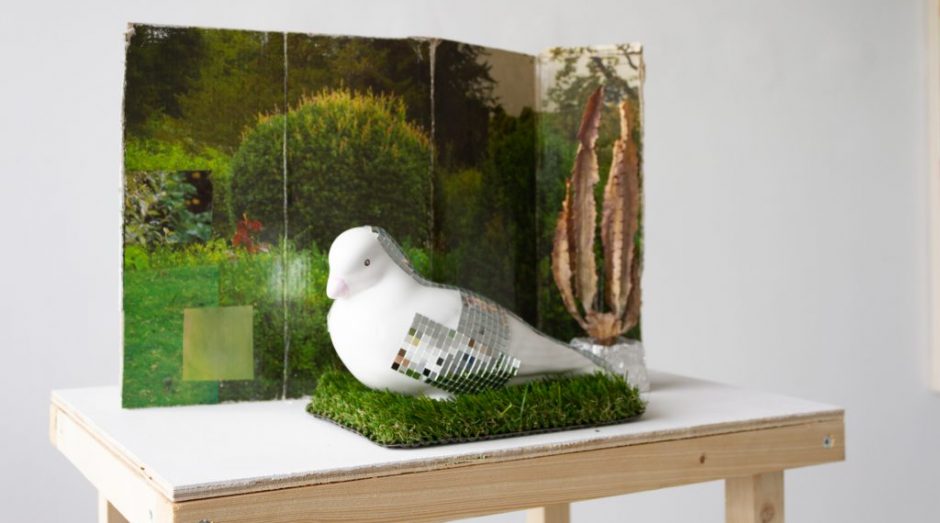
Painting by H, Watercolour on paper, 2025
_______________________________
Intro:
This case study explores my recent work with H, who is experiencing early to mid-stage dementia. We have termed the role ‘creative companionship,’ where weekly sessions aim to stimulate, enhance, and empower H’s creative skills and overall quality of life. Activities so far have included painting studies, monoprinting, salt dough sculptures, baking, and poetry. This report outlines the challenges encountered, and ways that art pedagogies can be used to plan for effective engagement.
Evaluation/Goal: (Name the challenge, opportunity)
Dementia presents cognitive and emotional challenges that impact daily interactions and creative expression. Some of the key challenges that I have witnesses are:
- Memory and cognitive variability
- Visual processing issues
- Physical limitations
The reflections and research will outline strategies for planning and facilitating workshops that take these challenges into account.
Plan of Action and Context:
For the first session working together, I plan a simple watercolour activity. I bring along painting materials: paint, brushes, paper, and also a bouquet of tulips to set up as a still life.
We begin the sessions by eating lunch together. This space of sharing and informality is crucial for building trust, and establishing connection.
As we wrap up lunch I introduce the activity that we will do and we begin setting up; (transforming H’s kitchen into a makeshift ‘studio’). I realise that I have forgotten a tablecloth. H has some old newspapers lying around that we decide would serve as good protection. However, one of H’s main challenges is in processing visual information – overlapping colours, shapes, and forms create confusion and disorientation. When we begin our painting, it quickly becomes apparent that the visually busy newspaper is causing a lot of confusion.
Not only that, but the still life itself is hard to focus on. There are questions regarding the orientation of what we are looking at, and concern of how to best translate what we were seeing onto the paper.
The Olser text articulates this state of bemusement as being central to the artistic process, noting that, ‘there is no artist that has not experienced this chaos-germ, where we do not see anything with clarity, and where everything seems to collapse… Painting is a discovery about the self, where things may appear when you do not expect them. It is about trusting who you are and letting your imagination guide your action and visual experiences. (Osler, 2019, p 115)
However, dementia has caused some distrust surrounding H’s physical and visual abilities. It is here that working together, through supportive dialogue, and collaboration feels really important, and serves as the foundation for my work as an educator. Collaboration is key to the general experience of lesson planning, facilitating a classroom, and the encountering of artwork (see Schwabsky, 2019). However, it is also important that H holds much individual autonomy and agency.
After one carefully considered and successful painting we try another. This time we experiment with focusing on just one flower from the bunch; laying it onto our working paper, and tracing along its contours. This attempt not only produced interesting visual results, it also seems to provide H with more confidence – when visual processing becomes tricky, H relies more on her sense of touch.
Other successful painting sessions have been more abstract in nature. Painting while listing to music seemed to connect well with H’s sense of intuition. During this session she comments about how the pace of the music helps her think and make decisions quickly. At the end of the day we look though what we have done – remembering the music through visual score, and reflecting on the work made during past sessions.
The planning of the lessons with H have different objectives than the lessons with students from Chelsea, emphasising ‘divergent’ over ‘convergent learning’ (Lindstrom, 2012) . While it is helpful to have some visual references there is less emphasis on theory, concept, and outcome, and more weight placed on the process of making, experimentation, and play. However, building off conclusions made in Case Study 1, it seems that play with H requires quite a lot of structure. The structure helps ground the activity in a space of accessibility. ‘It is play that encourages confidence and an opening up. It is play that promotes a sense of freedom!’ (MCA, Australia)
_____________________________
References/Bibliography:
A report on a three-year pilot research program – Artful: Art and dementia. (2020). Available at: https://www.mca.com.au/files/documents/MCA_Artful_Report_July_2020.pdf [Accessed 22 Aug. 2022].
The Museum of Modern Art (n.d.). Meet Me | Art Discussion Programs for Individuals with Dementia. [online] youtube. Available at: https://www.bing.com/videos/riverview/relatedvideo?q=meet+me+art+making+programs+for+individuals+with+dementia&mid=AB104C8BE79AF277469BAB104C8BE79AF277469B&FORM=VIRE [Accessed 2009].
OSLER, T., GUILLARD, I., GARCIA-FIALDINI, A. and CÔTÉ, S. (2019). An a/r/tographic métissage: Storying the self as pedagogic practice. Journal of Writing in Creative Practice, Volume 12(Numbers 1 & 2).
Schwabsky, B., Colvin, R. and Sam, S. (2019). The observer effect : on contemporary painting. Berlin: Sternberg Press.
Silberner, J. (2012). Alzheimer’s Patients Turn To Stories Instead Of Memories. [online] NPR. Available at: https://www.npr.org/sections/health-shots/2012/05/14/152442084/alzheimers-patients-turn-to-stories-instead-of-memories.
